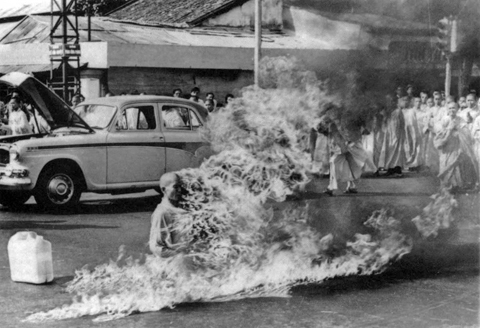
ICONIC IMAGE Malcolm Browne’s 1963 photograph. |
Action Speaks, the panel discussion series at Providence art space AS220, continues November 7 with a look at the power of the image.
Moderator Marc Levitt always uses an underappreciated date in history as the jumping off point for the chat. And this time it's 1908, when teacher and photographer Lewis Hine snapped pictures of child laborers that awakened the nation.
The discussion, free and open to the public, begins at 5:30 at AS220, 115 Empire Street. Among the scheduled panelists — Dan Czitrom, a history professor at Mount Holyoke College and author of the well-received Rediscovering Jacob Riis: Exposure Journalism and Photography in Turn of the Century New York.
The Phoenix caught up with Czitrom for a Q&A, via e-mail, in advance of his appearance.
PICTURES AND VIDEO HAVE AN ENORMOUS CAPACITY TO INFLAME THE CONSCIENCE AND ENCOURAGE SOCIAL CHANGE. MAKE A CASE FOR THE SINGLE MOST IMPACTFUL VISUAL OF THE LAST 50 YEARS. If we can tweak the 50-year limit, I would argue for the casket photograph of the badly mutilated Emmett Till, the 12-year-old African-American boy brutally murdered in Mississippi in August 1955. A Chicago native, Till was visiting relatives when an ambiguous encounter with a white woman led to his lynching. His mother, Mamie Till, insisted on an open casket funeral in Chicago. "People had to face my son and realize just how twisted, how distorted, how terrifying race hatred could be," she later said. "The whole nation had to bear witness to this." Several African-American publications, including Jet and the Chicago Defender, published a gruesome photograph of Till's corpse, but no mainstream white newspapers or magazines ran it. The shock and outrage among blacks, especially in the North, helped galvanize protest around Till's murder and the speedy acquittal of those charged with his murder. Many African-Americans, especially young people, later pointed to the Till photograph as a critical moment in raising civil rights consciousness. The Till photo might also be seen as a harbinger of the power that modern media had to shine the light of publicity on American apartheid. The fact that the photo did not appear in white mainstream publications underlined the institutional racism in American media, which itself would be transformed by the movement.
If we absolutely need to stick with the 50-year limit, I would point to Malcolm Browne's June 1963 photograph of a Buddhist monk [on this page], Thich Quang Duc, setting himself on fire in protest against the repressive regime of South Vietnamese leader Ngo Dinh Diem. This shocking image of self-immolation appeared on the front pages of newspapers here and around the world, and thus raised powerful doubts about the Vietnam policy being pursued by the Kennedy administration. This one image — simple, direct, human, and appalling — forced millions here and around the world to question all the press releases, policy papers, and press conferences aimed at reassuring Americans that our cause in Vietnam was just.
AS WE MOVE FROM A CULTURE OF THE BOOK TO A CULTURE OF THE SCREEN, IS IT EASIER OR HARDER FOR AN IMAGE TO BREAK THROUGH? It is clearly harder for a single image to break through in the rapidly changing modern media environment. Today we are more likely to be watching and talking about a video "gone viral" than discussing the impact of a photo. The continued decline of newspapers and news magazines no doubt weakens the potential power of the still image. As our "data smog" thickens, this trend is unlikely to be reversed.